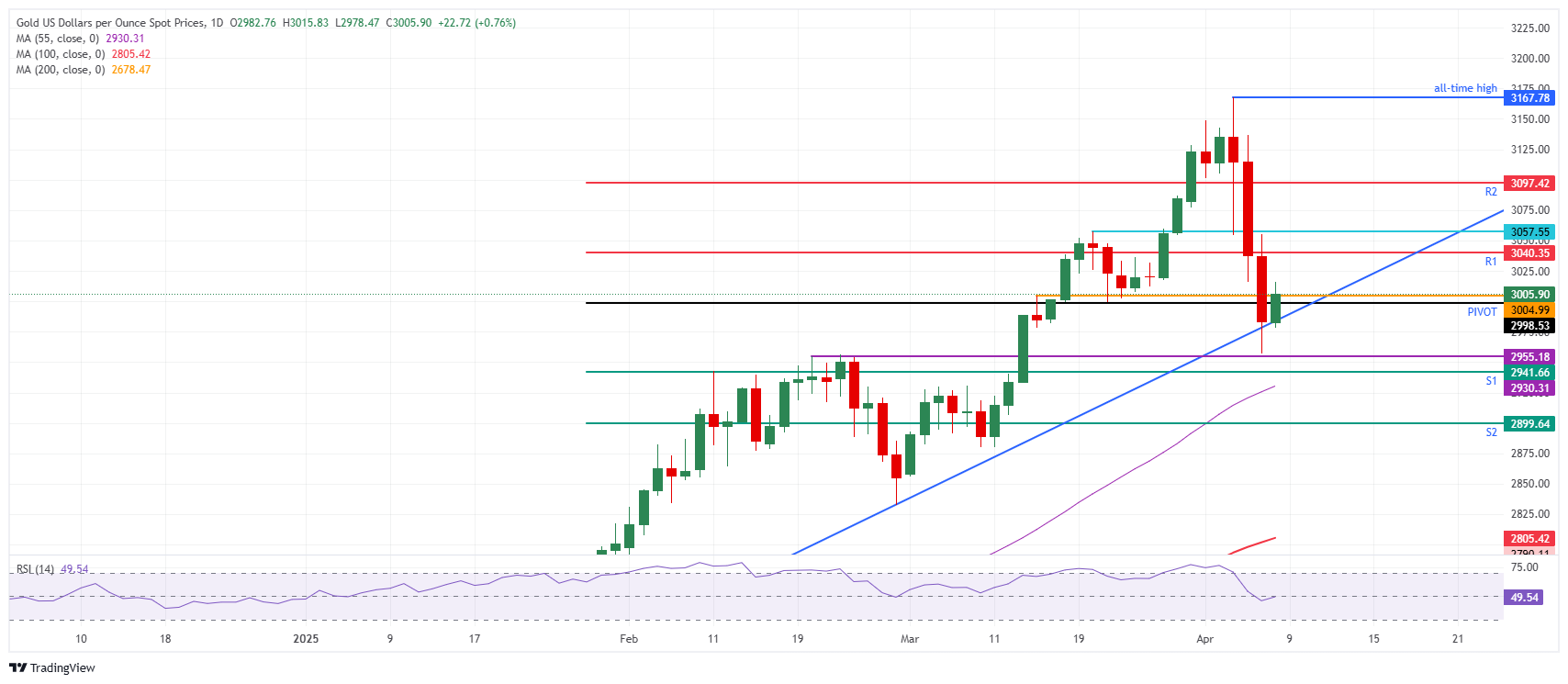- Gold price bounces off vital support at $2,955 and tries to snap losing streak.
- Markets should still favor Bullion as the safe bet for any stagflation or recession scenario.
- Gold bounces off from $2,955 and pops back above $3,010, gaining nearly 1% intraday.
Gold price (XAU/USD) edging higher together with Equities after their stellar nosedive move on Monday and past Friday. The precious metal trades just above the $3,000 mark at the time of writing on Tuesday. The bounce is supported by a technical element on the one hand and a geopolitical driver on the other. That last one is the tit-for-tat war between China and the United States (US) spiraling out of control. US President Donald Trump threatened to impose an additional 50% tariff on Chinese imports.
Meanwhile, traders are sending the US yield curve all over the place. At a given point on Monday, investors were betting on five interest rate cuts from the Federal Reserve in 2025, quite a change compared to the one-or-none stance from just a week ago.
Daily digest market movers: Gold Road undervalued
- West Australia’s Gold Road Resources says a scoping study on its flagship asset suggests there is more Gold than first thought, a clear indication that a $3.3 billion takeover bid from its joint venture partner undervalues the company, Financial Review reports. On Tuesday, Gold Road Resources released new data that showed the open-pit mine could hold more ounces underground that can be tapped profitably.
- The CME FedWatch tool shows chances for an interest rate cut by the Fed in May’s meeting standing at 31.7%, falling back from nearly 50% on Monday. For June, the chances of a rate cut are 96.9%, with a slim 3.1% chance for no rate cut at all.
- In his latest move, Trump threatened to slap an additional 50% levy on Chinese imports, while Beijing responded by saying it’s prepared to “fight to the end.” Shares in Europe rebounded from the worst three-day loss in five years, while US equity-index futures pointed to gains on Wall Street after Monday’s dizzying swings. Treasuries advanced after Monday’s sharp selloff. Oil gained while Gold climbed for the first time in four days. The US Dollar slipped against major peers, Bloomberg reports.
Gold Price Technical Analysis: Bits and pieces
Gold, known as a safe haven asset, is unable to withstand selling pressure when market turmoil spreads to all asset classes, as seen in the past few days. That is something to keep in mind, meaning that the precious metal will not recover back to the all-time high at $3,167 in a straight line, as trade war tensions are set to take place from here on out.
Looking up, resistances are a bit spread out, with the first cap at $3,040 as the R1 resistance, followed by $3,057, a pivotal level since March 20. Further up, the R2 resistance at $3,097 precedes the current all-time high at $3,167.
On the downside, the pivotal level of the March 14 high at $3,004 roughly coincides with the $3,000 round number and is trying to provide support as writing. If this area does not hold as support, bears can target $2,955, where clearly many buyers were interested in scooping up Gold on Monday. Further down, the S2 support at $2,899 is the last line of defence, with the 55-day Simple Moving Average (SMA) coming in already in advance at $2,930.

XAU/USD: Daily Chart
US-China Trade War FAQs
Generally speaking, a trade war is an economic conflict between two or more countries due to extreme protectionism on one end. It implies the creation of trade barriers, such as tariffs, which result in counter-barriers, escalating import costs, and hence the cost of living.
An economic conflict between the United States (US) and China began early in 2018, when President Donald Trump set trade barriers on China, claiming unfair commercial practices and intellectual property theft from the Asian giant. China took retaliatory action, imposing tariffs on multiple US goods, such as automobiles and soybeans. Tensions escalated until the two countries signed the US-China Phase One trade deal in January 2020. The agreement required structural reforms and other changes to China’s economic and trade regime and pretended to restore stability and trust between the two nations. However, the Coronavirus pandemic took the focus out of the conflict. Yet, it is worth mentioning that President Joe Biden, who took office after Trump, kept tariffs in place and even added some additional levies.
The return of Donald Trump to the White House as the 47th US President has sparked a fresh wave of tensions between the two countries. During the 2024 election campaign, Trump pledged to impose 60% tariffs on China once he returned to office, which he did on January 20, 2025. With Trump back, the US-China trade war is meant to resume where it was left, with tit-for-tat policies affecting the global economic landscape amid disruptions in global supply chains, resulting in a reduction in spending, particularly investment, and directly feeding into the Consumer Price Index inflation.

